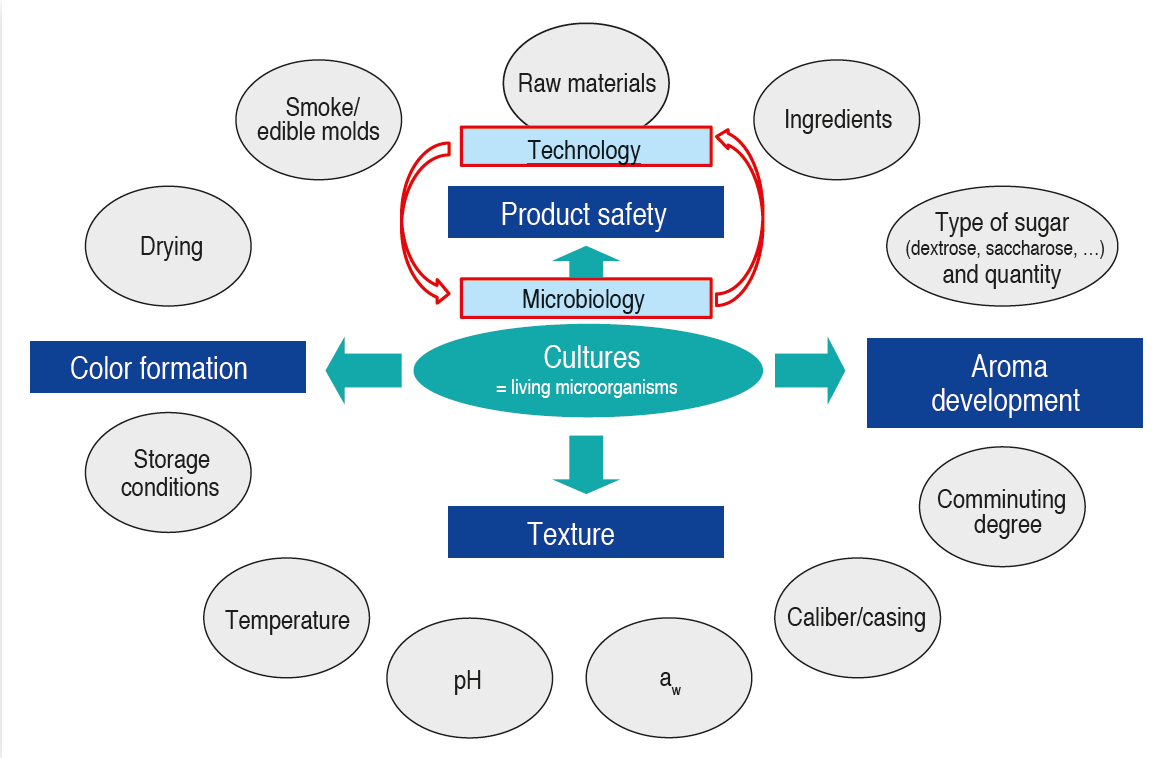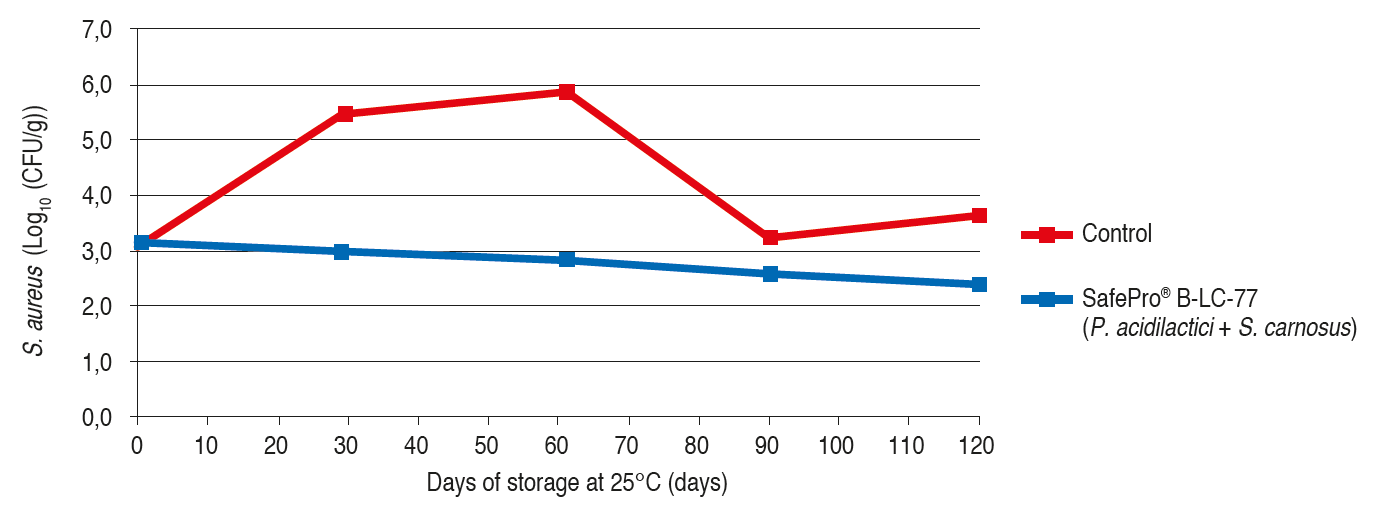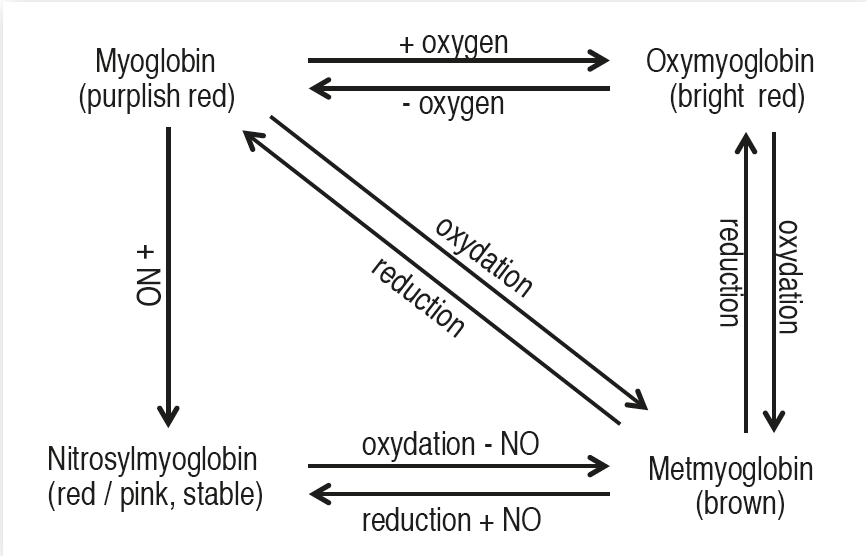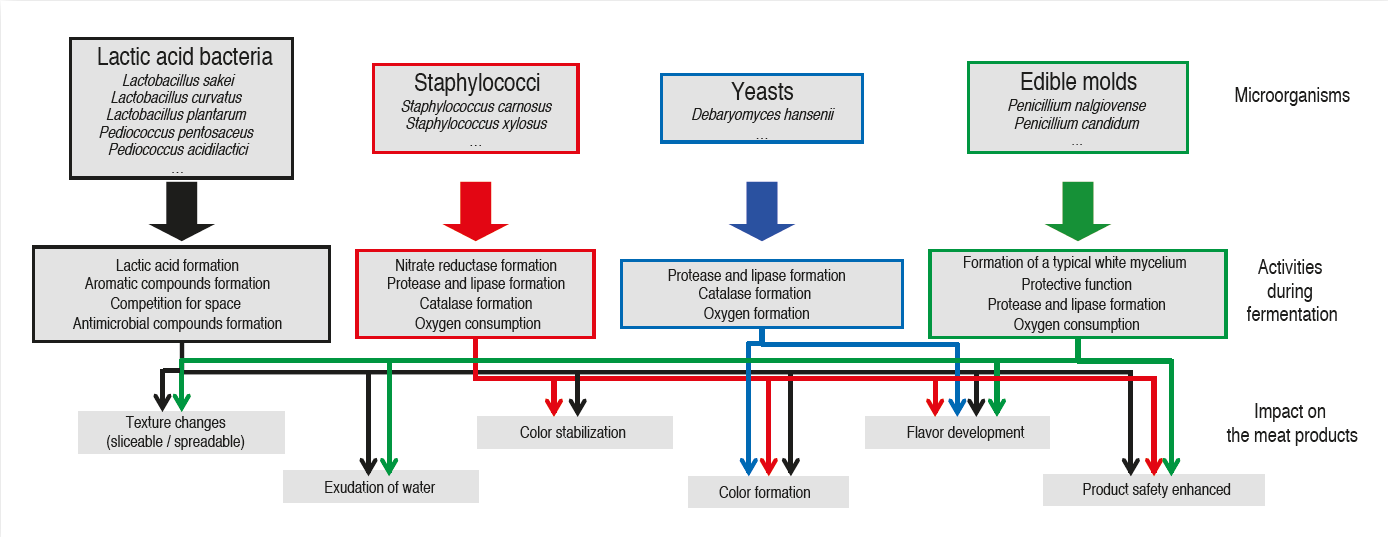Cultures in salami and raw cured muscles applications
DLG Expert report 3-2018
Introduction
Sauerkraut, cheese and sausages are examples of food products obtained by one of the oldest processes still in use: fermentation. Already known more than 10 000 years ago for the storage and the transport of food products, the principle of fermentation was however understood much later by Pasteur, in 1857. Described as “the life without air”, fermentation consists in low-energy biochemical reactions occurring in the food matrix (Ockerman H.W. & Basu L., 2014). Natural, this phenomenon is due to the growth of live bacteria present in the raw materials and in the environment of the factory.
Raw meat supports the growth of various microorganisms, notably because of its pH-value (around 5.6 – 6.1 for pork meat and around 5.6 – 6.5 for beef meat), its high water activity (aW) (around 0.99) and its high protein content (around 22 g/100 g for lean beef and pork meat) (Puolanne E.J., Ruusunen M.H., & Vainionpää J.I., 2001), (Garriga M. & Aymerich T., 2014), (F.A.O., 2015). If no preservation method is applied, safety of meat products is thus quickly compromised. As a matter of fact, more than 21 % of the food outbreaks registered in 2014 in Germany were linked to the consumption of meat and meat products (Bundesinstitut für Risikobewertung, 2016). Food safety of meat products has been enhanced from ancient time by combining fermentation to preservation processes such as curing and drying. Responsible of significant changes of the characteristics of the matrix, such combinations contribute to inhibit the growth of various undesired microorganisms, e.g., pathogens and spoilage flora. They also participate in the development of typical characteristics of a wide variety of products made from raw meat, such as salamis and other raw cured meats – mainly regarding their flavor, color, texture and contribute to the product stability and safety.
Salamis are made with meat and fat, mixed and stuffed in casings and eventually covered on their surfaces by molds (Bundesministerium für Ernährung und Landwirtschaft, 2015). The glycogen reserves in the tissues and the added sugar are fermented into lactic acid, which acidifies the matrix. Products are more or less dried, causing the migration of water to the surface of the product, its evaporation and thus a decrease of the decrease of the aW.
Raw cured muscles are cured with salt and eventually with nitrite, nitrate or both (Bundesministerium für Ernährung und Landwirtschaft, 2015). Curing is either performed by diffusion (by hands, in a tumbler or by immersion in the brine) or by injection (curing salts are added into the brine which is then injected into the core of the meat). It always conducts to a decrease of the aW-value, enhanced by the drying step.
Quality of the fermented meat products is not only process-dependent. It is also significantly impacted by the microbial and technological quality of the raw materials used. Good manufacturing and hygiene practices remain thus a must.
Inoculation of fermented meat products with selected microorganisms to enhance their quality and safety
The high salt content of cured meat products (from 1.7% to concentrations higher than 3%) (Petäjä-Kanninen E. & Puolanne E., 2014) inhibits or delays the growth of some endogenous microorganisms. However a wide diversity of microorganisms is still able to grow in such an environment, including the ones responsible of fermentation as well as others, responsible of spoilage, of biogenic amine production or of foodborne diseases.
Fermentation was traditionally insured either by microorganisms from the endogenous flora or by backslopping from the remains of earlier production charges. But because of the diversity of the microorganisms able to grow in the matrix, quality of fermented meat products was variable (Petäjä-Kanninen E. & Puolanne E., 2014) from high to poor quality (e.g., products not fermented, spoiled or contaminated by pathogens). Such discrepancies were noticeable even between products identically processed.
Patents for using selected microorganisms for meat fermentation were already registered in the twenties, reflecting the will to enhance the safety, to control and to standardize the characteristics of the fermented meat products (Kurk F.W., 1921). Moreover, unlike backslopping, the use of commercial microorganisms is compatible with the accurate quality requirements regarding traceability of the raw materials and ingredients used. Nowadays, most of the meat products to be fermented are thus inoculated with commercial preparation of cultures. Being “in themselves a characteristic food ingredient”, cultures are “concentrates (> 8.0 Log10 (Colony Forming Units (CFU)/g or mL)) of one or more live and active microbial species and/or strains” (EFFCA, 2015). Safety of these microorganisms has to be validated before use, e.g., by demonstrating the absence of transferable antibiotic resistance genes, of biogenic amine or of toxin production.
The microorganisms selected to be used as culture are isolated from the endogenous flora of similar foods. Most of them are lactic acid bacteria (L.A.B.), coagulase-negative staphylococci, yeast or molds. Well-adapted to the meat matrix, they dominate the endogenous flora throughout the process, the inoculated L.A.B. reaching for example a final count between 7.0 and 9.0 Log10 (CFU/g). However, activities and functionalities of the microorganisms are highly affected by external parameters during the fermentation process (see Figure 1). Characterization of their metabolic activities at temperatures typical of the process and of the storage, and in various matrices (with high-salt content, in presence of nitrates or nitrites, in anaerobic conditions …) is thus essential to select the best culture(s) for the fermentation of a targeted meat product. Because of the changes occurring in the meat matrix throughout the fermentation, growth and metabolic activities of the microorganisms may be impacted. Variation of these parameters has thus to be considered while characterizing the microorganisms, as they may have a significant impact on the product characteristics.
Inoculating meat products with well-characterized microorganisms contributes thus not only to improve the safety of the products and to optimize the process, but also to improve their quality and to reduce the inter- and intra-batch variability. Reduction of the food waste is therefore possible – compared to the production of spontaneously fermented meat products.
Effect of the main microorganisms responsible of the transformations occurring during fermentation of raw meat products – focus on salamis and raw cured muscles
Lactic acid bacteria
Dominating flora of the salamis, L.A.B. (mainly lactobacilli and pediococci (Marianski S. & Marianski A., 2015)) may also be added to raw cured muscles to enhance the quality of the curing. L.A.B. are able to degrade sugars into lactic acid and thus to acidify the meat matrix. This pH-decrease is however strain-dependent (see Figure 2). Products should thus be inoculated with culture(s) known to be well-adapted to the raw materials, to the ingredients and to the process used, i.e., able to grow throughout the fermentation and capable of acidifying the matrix as much and as fast as wanted.
Lactic acid is an antimicrobial metabolite. The quicker it is produced, the quicker the pH decreases and the least other undesired microorganisms are able to grow. Moreover, by acidifying the meat matrix, lactic acid production conducts to the solubilization and to the coagulation of the proteins. Texture formation and water-binding capacity are therefore affected (Monin G. & Santé-Lhoutellier V., 2014), so is the drying process.
Well-adapted to the meat environment, L.A.B. stabilize the microbial ecosystem of the meat products and inhibit significantly the growth of pathogens (Upton M., 1995). Indeed, they compete for space with the minority flora and produce metabolites – such as organic acids – which have an antimicrobial effect against undesired flora, e.g., pathogens. The growth of Staphylococcus aureus is for example inhibited in sliced cured ham stored at room temperature until the end of its shelf life, when inoculated with the culture SafePro® B-LC-77 (Pediococcus acidilactici and Staphylococcus carnosus) (see Figure 3). Otherwise, the storage at chilled temperature remains a must for such products.
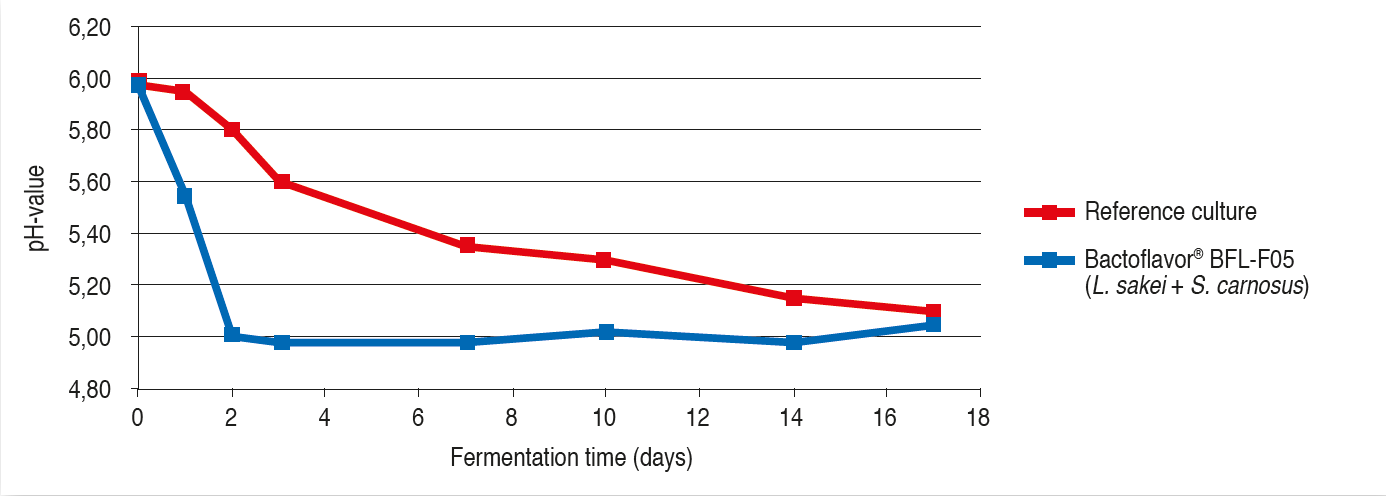
Efficacy of the culture regarding microbial inhibition in a particular matrix is however strain-depend, as it relies among other on their metabolic activity. For example, growth of Listeria monocytogenes is better inhibited in salamis inoculated with the culture SafePro® Flora Italia LC (Lactobacillus sakei, Pediococcus acidilactici and Staphylococcus carnosus) than in those inoculated with a reference culture (see Figure 4).
L.A.B. contribute also to the flavor development of the fermented meat products, as they produce lactic acid – contributing to the sensorial properties of fermented sausages – and small amounts of various aromatic compounds such as ketones and aldehydes.
Finally, it has been noticed that a pH-decrease – even as small as 0.2 units – raises the rate of color formation in meat through nitrite-myoglobin reaction (Sofos J.N., 1981). Production of lactic acid by L.A.B. favors thus the color formation.
Coagulase-negative staphylococci
Coagulase-negative staphylococci (S. carnosus and S. xylosus) and other genus from the Micrococcaceae family (such as Kocuria) producing nitrite and nitrate reductases are responsible of the reddening of fermented meat products (Marianski S. & Marianski A., 2015). These enzymes reduce nitrate into nitrite, thus reduced into nitric oxide (NO). NO bonds to the ferric ion of the myoglobin to form the pigment responsible of the typical red color of fermented meat products: nitrosomyoglobin (Honikel K.O., 2014) (see Figure 5).
Catalase synthetized by staphylococci degrades the peroxides of the meat products and contributes thus to stabilize the color, to reduce the oxidation and to delay the appearance of rancidity.
Moreover, the protease produced hydrolyzes proteins of the matrix into smaller proteins, peptides and amino acids. Crucial to the bacterial nutrition, this enzyme conducts to the formation of nice flavor and taste. Lipolysis participates also to the flavor development occurring during fermentation, as it releases free fatty acids which are then oxidized into aromatic compounds such as ketones and aldehydes (Garry P. & Le Guern L., 1999).
In summary, staphylococci contribute to the formation and stabilization of the nitrosomyoglobin, play a role in preventing rancidity and produce aromatic compounds. They also enhance the microbial safety of the products – by reducing nitrate into nitrite (Marianski S. & Marianski A., 2015). But as the coagulase-negative staphylococci count is usually low in the raw meat matrices, color of dry cured hams spontaneously fermented is hardly homogenous. Meat products are therefore more and more inoculated with cultures containing staphylococci.
Yeast and molds
Presence of yeasts having a tolerance to high salt content such as the ones from the genus Debaryomyces (mainly D. hansenii) (Marianski S. & Marianski A., 2015) is often noticeable on the surface of fermented sausages. Their metabolism contributes to the flavor development of the products, which is mostly due to the lipolytic and proteolytic activities.
Mold cultures form the typical white mycelium on the surface of air-dried sausages that is characteristic for the appearance of mold-ripened salamis. As a result of displacement and competition effects, this inhibits and suppresses the growth of undesirable and possibly toxin-producing molds from the environmental flora. This mold mycelium has a regulating effect on the drying operations and protects thus the product against the formation of dry crusts. Mold cultures such as Penicillium nalgiovense or Penicillium candidum display pronounced proteolytic and lipolytic activities which are responsible for forming the characteristic mold aroma (Marianski S. & Marianski A., 2015). The proteolysis leads also to an increase of the pH-value in the course of the fermentation, causing the typical medium-soft texture of mold ripened products.
As illustrated in Figures 1 and 6, the interaction of the metabolism of all of the microorganisms present in the food matrix with the environment is central to optimize the development of the flavor, color and texture targeted, to stabilize those parameters and to enhance the food safety.
Conclusion
For centuries, microorganisms have been used on an empiric way to produce tasty and stable food. In numerous meat products, microorganisms play an essential role by generating or at least influencing the characteristic properties including flavor, color, texture and shelf life. Ongoing research, novel microbiology and meat technology methods have enabled us to better understand the complex fermentation processes and to control these by the targeted use of selected cultures. This is what made the control of the production processes of many food products possible. Today, selected microorganisms are considered as food ingredient and labelled as “culture”. Their targeted use is state-of-the-art in many fermented meat applications. Fermentation is considered as one of the oldest and healthiest way to preserve food (Enders G., 2015), and accordingly the use of cultures is not only limited to fermented meat any longer, but attracts a growing attention for new applications, e.g., meat preparations, cooked meat or smoked fish, where it opens up a wide range of opportunities to improve the food quality and safety as well.
Contact:
Michael Erkes, Chr. Hansen GmbH, demer@chr-hansen.com
Simone Schiller, Managing Director of the DLG Competence Centre Food, Frankfurt am Main, S.Schiller@DLG.org


